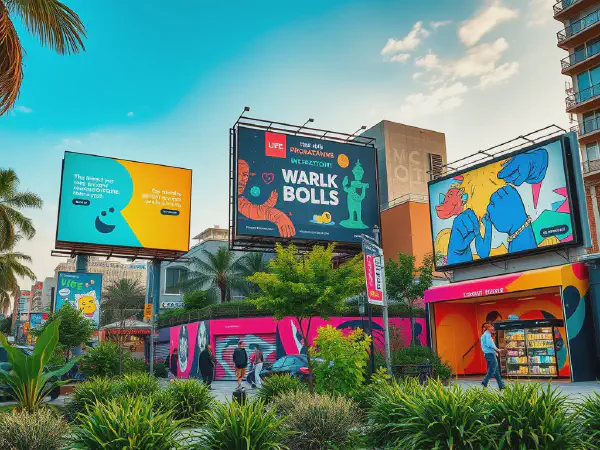Creative Strategies for Small Businesses in Outdoor Advertising

The Power of Outdoor Advertising
Outdoor advertising, also known as out-of-home (OOH) advertising, is a powerful and effective marketing strategy that involves placing advertisements in public spaces. This form of advertising reaches consumers when they are out and about, whether they are walking, driving, or waiting for public transportation. Outdoor advertising allows businesses to reach a wide audience, create brand awareness, and promote their products or services.
One of the key advantages of outdoor advertising is its ability to capture attention. Unlike other forms of advertising that can be easily ignored or skipped, outdoor ads are placed in locations where consumers cannot avoid them. They are visible 24/7, making them highly effective in terms of exposure and reach.
There are various types of outdoor advertising that businesses can utilize to convey their message to the target audience. Billboards, digital signage, transit advertising, and street furniture advertising are some of the popular forms of outdoor advertising.
Billboards are large displays placed in high-visibility locations such as highways, city centers, and busy intersections. They are a great way to reach a broad audience and create brand recognition. Digital signage, on the other hand, utilizes digital screens to display dynamic and engaging content. These screens can be found in shopping malls, airports, and other high-traffic areas.
Transit advertising involves placing ads on buses, taxis, trams, and other forms of public transportation. This type of advertising allows businesses to reach a targeted audience during their daily commute. Street furniture advertising includes ads placed on bus shelters, kiosks, and benches. These ads are strategically placed in areas where people gather or wait, ensuring maximum exposure.
Designing Effective Outdoor Ads
When designing outdoor ads, it is crucial to create visuals that are eye-catching and memorable. The use of large, bold images or graphics helps grab attention from a distance. Clear and concise headlines are also important in conveying the message quickly.
Incorporating a strong call-to-action is essential for driving consumer action. Whether it is encouraging them to visit a store, call a phone number, or visit a website, a clear and compelling call-to-action can significantly impact the effectiveness of the ad.
Optimizing for viewing distance and location is another important aspect of outdoor ad design. Understanding where the ad will be placed and how far away it will be viewed helps determine the font size, color contrast, and overall layout of the ad.
Using eye-catching colors and fonts can make a significant difference in attracting attention and conveying the intended message. Bright and contrasting colors, along with legible fonts, ensure that the ad stands out in its environment.
Targeting the Right Audience
To maximize the impact of outdoor advertising, it is essential to target the right audience. Understanding the target market helps ensure that the ad message resonates and connects with the intended audience.
Researching demographics and behaviors can provide valuable insights into the target audience's preferences, interests, and habits. This information helps in crafting ads that are tailored to their needs and desires.
Using geolocation targeting can further refine the audience reach. By considering the physical location of the ad and the target audience, businesses can optimize their advertising efforts and increase relevance.
Tailoring messages to specific audience segments allows businesses to create personalized and impactful ads. By understanding the different needs and motivations of various segments, businesses can create messages that resonate with each group.
Measuring Outdoor Ad Performance
Measuring the effectiveness of outdoor advertising is crucial in determining its success and optimizing future campaigns. There are several key metrics that can be used to measure outdoor ad performance.
Tracking impressions and reach provides insights into how many people are exposed to the ad. This data helps businesses understand the reach and potential impact of their outdoor ads.
Monitoring website traffic and conversions after launching an outdoor ad campaign can provide valuable data on the effectiveness of the ad in driving online engagement and conversions.
Conducting surveys and customer feedback can provide qualitative insights into the audience's perception and response to the outdoor ad. This data helps in understanding the ad's impact on brand perception and customer behavior.
Analyzing competitor campaigns can provide valuable insights into the effectiveness of different strategies and tactics used in outdoor advertising. By benchmarking against competitors, businesses can identify areas for improvement and develop more impactful campaigns.
Creative Budgeting for Outdoor Advertising
When budgeting for outdoor advertising, it is essential to determine the advertising budget based on the overall marketing goals and objectives. Allocating a portion of the marketing budget specifically for outdoor advertising ensures that it receives the necessary resources.
Exploring cost-effective outdoor advertising options can help businesses optimize their ad spend. This can include partnerships with local businesses or organizations, utilizing unused ad spaces, or exploring alternative forms of outdoor advertising.
Negotiating deals and partnerships with outdoor advertising providers can help businesses secure better rates and maximize their budget. Building relationships with providers can lead to long-term cost savings and strategic partnerships.
Calculating the return on investment (ROI) is essential in evaluating the effectiveness of outdoor advertising. By comparing the cost of the ad campaign to the results and benefits achieved, businesses can make informed decisions about future investments.
Innovative Outdoor Advertising Ideas
Innovation is key to standing out in the world of outdoor advertising. Integrating interactive displays and augmented reality can create unique and immersive experiences for consumers.
Incorporating mobile marketing techniques, such as QR codes or NFC tags, can bridge the gap between outdoor advertising and online engagement. This allows consumers to interact with the ad and access additional information or offers.
Utilizing social media integration can amplify the impact of outdoor advertising. Encouraging consumers to share their experiences or participate in social media campaigns related to the ad can generate additional buzz and reach.
Partnering with local events and organizations can provide opportunities for creative and targeted outdoor advertising. Sponsoring events or aligning with relevant causes can enhance brand visibility and engagement.
